
|
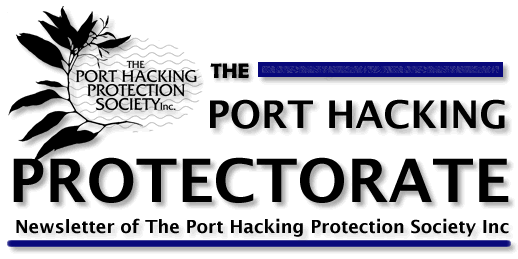 |
November 1998 |
|
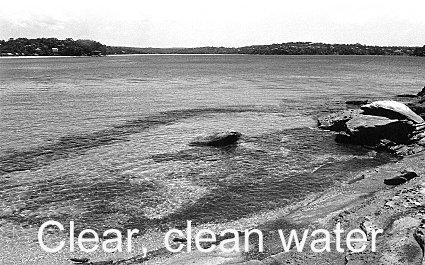 |
Editorial - Clear, clean water
By Phil Parsonage
Safe to drink in the upper catchment. Safe to swim in everywhere in the Hacking, Safe enough to fish in and to boat in. Aesthetic.
That's what every community survey overwhelmingly shows the community wants.
Why then, does the EPA want to downgrade the Hacking River's present classification as a "P" (Protected) class river?
Currently, the "P" classification places controls on activities that can take place in the upper catchment and also requires strict and ongoing pollution control. Reclassification, which will reduce the classification from drinking water quality to non-drinking water quality will effectively remove these controls.
Several organisations, including the Sutherland Shire Environment Centre, the National Parks Association and the Hacking River Catchment Management Committee, have made submissions that the reclassification is inappropriate.
The Sutherland Shire Environment Centre argues that: "The proposal ignores the quality requirement for the conservation of species in a National Park and neighbouring bushlands. It ignores the health of the millions of Park visitors who will swim and wade in the Hacking's waters... The Draft Proposal by the EPA condemns the waters of the upper catchment because one of its tributaries (Camp Creek) is adversely affected. Otford is to be sewered. The coal mine has shut down, thereby negating the only licence to discharge into the catchment. Hence we are on the road to improvement and, sadly, the only obstacle remaining appears to be the deficiencies in this proposal."
The National Parks Association's submission noted that "The fact that some tributaries and indeed the main river will probably remain unsafe to drink from for some time (because of the impact of Otford on the Hacking River and Camp Creek which drains Helensburgh) does not mean that there should not be the highest possible OBJECTIVES for water quality for the freshwater parts of the catchment (which most NPA members, and especially bushwalking members, currently assume and treat as, drinking quality water)."
Tim Tapsell's letter printed in this issue reiterates we need to be ever vigilant to maintain the water quality we currently have and strive ever for better than what we have.
Good water quality, as we know, is only achievable if we assure that a whole lot of programs are properly in place, from stormwater quality control, to development controls, to biodiversity issues, to usage of the waterway. But the programs, as PHPS consistently reiterates, need to be integrated and prioritised. The biggest threat to the integrity of Port Hacking is incremental approaches to isolated problems and development that has the cumulative effect of destroying the whole that the community cherishes.
PHPS has consistently worked towards an integrated approach to all issues by supporting initiatives such as: The establishment of the Hacking River Catchment Committee: the Memorandum of Understanding for the Port Hacking regarding the framework in which navigational dredging in Port Hacking should be carried out on a sustainable basis; and the Plan of Management for Port Hacking, being implemented under the direction of the Port Hacking Planning and Advisory Committee.
Unfortunately neither the Memorandum of Understanding nor the Hacking Plan of Management initiatives have been utilised to the extent that they might have been. The Memorandum of Understanding has been utilised only with regard to its recommendations on dredging, and not with regard to its more holistic recommendations on the sustainable use of the waterway. Yet at the outset, the agreement between environmental groups, Council and state government was that dredging would only be carried out within a program of environmental protection. It was, in fact a pre-condition by the state government for continued funding of dredging. By ignoring the underlying motive of the Memorandum, the Council and the state government are falling short of their claims of promoting environmentally sustainable activities.
An audit of progress on implementing the Hacking Plan of Management is currently under way. We hope to feature the audit's findings in the next issue of the Protectorate. The Port Hacking Planning & Advisory Committee, however, has only met a few times this year and rumoured decisions made by Council with regard to the Committee have taken some of its members by surprise.
A focus on isolated issues in Port Hacking (whether it be dredging, boating, urban development, bushcare, stormwater control, etc.) and its catchment without integration and prioritising within a holistic management plan, is a recipe that consigns Port Hacking to a slow path to degradation. A focus on water quality and on catchment issues provides a good basis for directing action.
The EPA's proposed reclassification, in this context, does seem to be a retrogressive step. It appears to be allowing the single issue problems (pollution associated with upper catchment developments) to dictate the standard of the whole.
We, as a community, should be setting targets for achieving a better environment, not falling back to a position of a more degraded one than we already have.
Shire Watch - Independants for Sutherland Shire Council |
 |
The Port's waters have finally cleared after the very heavy August rain when more than 430 mm (about 18 inches) of rain fell over a few days on the extensive catchment of the Hacking River and Port Hacking.
Street debris, erosion from many washaways and land collapses, natural erosion due to the huge rainfall and many sewer overflows all contributed to a very discoloured surface metre or so of mainly fresh water. Fresh enough to keep Sydney Minnows washed from rivers alive for several weeks. The bottom dwelling fish, like the Black Bream, remained, well fed by the food washed in, while the smaller surface fish like Sardines did not return until the water cleared in mid September. All appears to be normal now with many schools of different bait fish on the surface with larger fish below.
The heavy contamination would almost certainly mean that Port shellfish, such as oysters, are still unsafe to eat, and this is likely to continue as the EPA, through its Habourwatch and Beachwatch monitoring, has found heavy sewerage contamination on all Shire beaches and in Gunnamatta Bay all September. Harbourwatch samples the Port only at Gunnamatta Bay and a more realistic sample would include the swimming areas at Greys Point, Gymea, Lilli Pilli and Bundeena. Many people both swim and eat oysters at all these popular summer locations.
With the large tides now commencing, the ocean sewerage pollution will be swept well up into the Port meaning that shellfish will be suspect for many months and swimmers at risk through summer. |
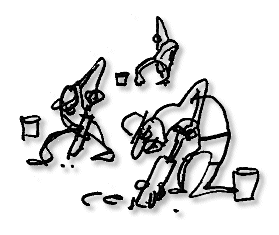 |
The solution is, of course, the long promised tertiary treatment plant at Cronulla, which Sydney Water has just announced will be commenced early next year and be operational by 2001. It is vital for the whole Shire and the Port that we keep our Local Members on the job so that other priorities and political fixes do not filch the money and further delay completion beyond 2001 - It is bad enough to not have clean water for the 2000 Olympics when shire tourism should peak, particularly when the plant upgrade was announced three years ago.
So is This How You Should Treat a Natural Watercourse?
Engineering practice has moved a long way since the 1950s when 'piping' of creeks was considered acceptable practice. Elsewhere engineers and local councils are trying to reverse such ill considered practices of a less enlightened time. Even State government policy says that piping of natural watercourses should be discouraged (and reversed wherever possible). |
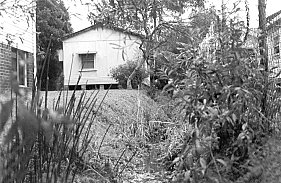 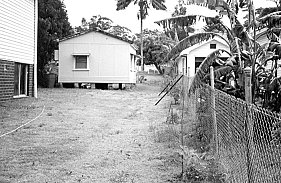 |
Come on Sutherland Shire Council - You Can Do Better Than This
And while on the subjects of character -
Below is a picture of a street that had a "heritage character" as well as a watercourse through dense vegetation. |
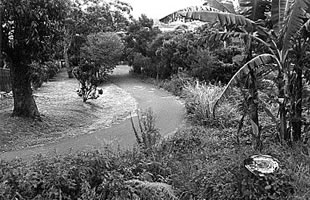 |
| Below is a picture of a the same street in the process of being "improved" (the watercourse has been piped). |
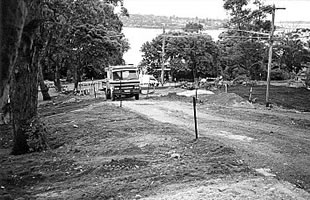 |
And all of this after assurances that nothing would be done to damage the natural character of the area.
Stop Press
Community Forum
The Hacking River Catchment Management Committee (HRCMC) held its first Community Forum on 28 June 1998 (see July issue of Protectorate). The aim of the Forum was to provide the community with up-to-date information on all activities occuring in the Hacking River catchment. Presentations from local, state government authorities (including NPWS, EPA, NSW Fisheries, Wollongong City Council, Sydney Water and Waterways Authority), environment groups and others have been compiled and will be available in late November. If you would like a copy please contact the HRCMC coordinator, Libby Rawlingson on 9895 7769.
The Hacking River Community Contract, which is an agreement by the catchment stakeholders (both government & community) to achieve measurable and achievable outcomes for environmental improvement has been signed by eight of the twelve stakeholders present at the forum including: HRCMC, DLWC, Sutherland Shire Council, PHPS, Helensburgh and District Landcare Group, Sutherland Environment Centre. Action plans for each organisation will be required.
Natural Heritage Trust (NHT) Funding
The Natural Heritage Trust will be funding a number of projects for the Hacking catchment in 1998/99. This is a positive move after last year's disappointing round of decisions (see Protectorate issue December 1998). In fact, last year, only .05% of funding from the Telstra sell-off made its way to urban community-based organisations. This year, 100% of environmental projects under state government programs which support community-based urban organisations such as Catchment Management Committees were funded.
A total of $316,000 was provided for community projects. Significant winners were groups in the Hacking River catchment:
One already very active group, the Helensburgh and District Landcare Group, in the upper catchment, will be even more active with major injections of funds to their efforts. Their projects span the range of activities required to work towards a sustainable future for the catchment, from hands-on to research. They aim, over the next three years to remove and monitor several dangerous weed species from the upper catchment of Hacking River. In addition, they will be developing an information database on the Hacking River Catchment for use by all parties interested in aspects of the catchment (landowners, environment groups, government authorities, etc.). The group will also be involved in disseminating information to upper-catchment communities about existing environmental problems and how current activities contribute to these problems.
The Port Hacking Littoral Rainforest Bushcare Group has been successful in attracting funding to address vegetation management and biodiversity issues in five remnant littoral rainforest sites along the Hacking River. |
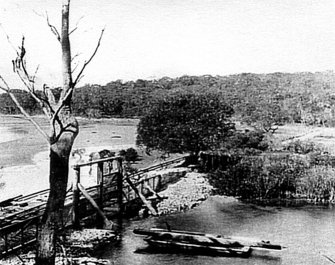 |
Springfest 1998
The Bundeena Community Centre was the location for the second "Community Biodiversity survey SPRINGFEST". National Parks & Wildlife Services, Sutherland Shire Council, Helensburgh & District Landcare Group, National Parks Association, Audley Field Study Centre, the Hacking River Catchment Committee, and the Port Hacking Protection Society set up displays targeting issues of biodiversity and sustainability. There were also several activities available for children to participate in. On Saturday night, a range of people spoke about environmental and biodiversity issues.
A key component of the Springfest was a series of biodiversity surveys that included surveying small mammals, night birds and frogs. At last!
The on-going illegal dumping on Cawley Road has almost become a regular feature in the Protectorate! Hopefully, the matter has now been resolved. The Department of Land and Water Conservation (DLWC) organised the removal of the last of the rubbish from Cawley Road, Helensburgh in the beginning of July. Several organisations were involved in the clean up including State Rail, Transgrid, EPA, Wollongong City Council, DLWC, NPWS, and Helensburgh and District Landcare Group, who provided both in-kind support and financial support. With the agreement of stakeholders, DLWC intend to permanently deny access to the area to all except emergency services and authorised agencies.
Dredging
Navigational dredging of Port Hacking will begin soon - although tender details need to be finalised. NSW Fisheries have endorsed the next navigation dredging on the basis that material be disposed of in the Lilli Pilli deep hole. They would, however, prefer material to be disposed of outside Port Hacking. They have stated that they will not approve disposal of material in Port Hacking after the year 2000. The HRCMC has recommended that if material is to be disposed of in the deep holes, it should be on the prograding fronts.
NSW Fisheries supports offshore disposal rather than estuarine disposal. Dredged material can be transported to Cronulla for beach renourishment rather than Kurnell's offshore bar for a minimal increase in funds. Indicating dredge spoil costs are approximately: $8-9 per cubic metre to the deep holes in Port Hacking; $11-12 per cubic metre to Lilli Pilli deep hole only; $15-50 per cubic metre to Cronulla Beach.
There has been little attention to implementing the Memorandum of Understanding, which set the environmental controls for better management of vessel moorings, protection of seagrass beds and protection of the interests of other Port user, both active and passive. Stormwater Management Plans (SMP)
The Environment Protection Authority (EPA) has directed all Councils to prepare SMPs. All agencies such as Sydney Water and the RTA have been issued Notices by the EPA to participate in plan preparation and their implementation.
The process for developing the SMP will incorporate the establishment of a Working Group comprising Council, CMCs (Catchment Management Committees), Sydney Water and the RTA. Plans will be prepared in consultation with stakeholders which include the community, CMCs, EPA, and DLWC and take into consideration recommendations from catchment, estuary or floodplain management plans. Wollongong City Council must develop 3 plans and Sutherland Shire Council must develop 2 plans for the Hacking and the Georges River. Progress with sediment control
Progress, although slow, is being made in sediment control efforts by Sutherland Shire Council (SSC). Auditing of private non-Council works are being carried out and protocols are being developed. Under pressure from various government and community-based groups, and after significant sediment dumps from Council works (Examination of SSC sites, including those at Wonga Road, Yowie Bay, and East Heathcote after heavy rains between 7th and 15th August showed overall effectiveness of sediment control methods, was very low. The devices failed to prevent sediment leaving sites.) into the Hacking catchment SSC is now also seriously addressing issues with its own works. As a first step, supervisory staff will attend erosion and sediment control training sessions.
Sewerage Scheme for Otford, Stanwell Park, Stanwell Tops, and Coalcliff.
Sydney Water is preparing an Environmental Impact Assessment (EIA) to determine the preferred option for the provision of sewerage services for upper Hacking catchment communities. Options being assessed range from the "do nothing" option (not favoured), to various combinations of local treatment and water re-use, to on-site treatment, to sewage collection and high level treatment at a new plant at Coalcliff with reclaimed water released into the old mine (most favoured).
A workshop with key stakeholders as participants was held on 11th and 12th August 1998. Conclusions from that workshop are much the same as those which arose from the Bundeena and Maianbar workshop deliberations on sewage treatment. This in spite of significant technological advances which highlight that large scale engineering solutions are not necessarily the best - neither for environmental nor economic reasons.
These issues have been discussed in detail in the recently published PHPS Document. Avoiding Another Tragedy of the Commons: The Bundeena Maianbar WaterCycle Management Study, which is available from PHPS, PO Box 744, SUTHERLAND 2232 Ph. (02) 9523 3680 PHPS Members' Price $5, Non-member's Price $11 (include $3 for postage) |
 |
Audley Fish Ladder
This ladder (heralded in the October 1996 issue of the Protectorate) has been in the planning stage for some time. Several organisations are involved in this project including NSW Fisheries, NPWS, RTA, Department of Public Works and DLWC. The design currently focuses on the eastern bank. However, the design concept has not been finalised and work has not started. There are several issues which have been agreed to, including effective biological transfer of fish above the weir, calming traffic across the weir, heritage value of the area and the need for educational aspects. What Our Councillors Say About the Port |
In the April 1996 issue of the Protectorate we asked the then new Sutherland Shire Councillors to send us their views regarding: The Memorandum of Understanding; Plan of Management for Port Hacking; Priorities Council should have with regard to environmental issues. Of the fifteen Councillors, twelve responded for the 1996 issue.
We have invited these twelve Councillors to review progress on the issues raised in 1996. We asked them these questions:
-
The Memorandum of Understanding: Your support for it now and its progress towards implementation during your time in office?
-
The Sutherland Shire Council's Plan of Management for Port Hacking: Your support for it now and the steps that have been achieved towards implementation during your time in office?
-
A number of environmental issues concerning Port Hacking were listed in the April 1996 issue of the Protectorate. Have the issues that you highlighted as of concern been significantly addressed in your time in office, and how?
-
Are there environmental issues you are currently working on and hope to have completed or substantially advanced before September next year.
The following are the Councillors unedited responses: |
|
Councillors Kevin Schreiber and Lorraine Rodden |
  |
I refer to your letter of 7 October 1998 in which you request information to a range of issues that effect the sustainable use and environmental health of Port Hacking. The following information is provided in response.
1. The Memorandum of Understanding - As you will be aware, tenders were called and evaluated for maintenance dredging in Port Hacking. The exact commencement date is not known as much of this depends on the availability of the preferred contractor.
As the Department of Land and Water Conservation is providing the funds for the maintenance dredging, it will be responsible in appointing the preferred contractor having regard to the input of Council, who is acting as contract manager for the project.
Council is committed to ensure that navigation channels are maintained within the Port to a standard that provides a free and reasonable access to the boating community and in this regard will continue with its efforts to expedite the dredging of Port Hacking. Council is also a participant to the Hacking River "Community Contract" which is an agreement by all catchment stakeholders to work together to achieve measurable and achievable outcomes for environmental improvement.
2. Plan of Management for Port Hacking - Council's Port Hacking Planning and Advisory Committee is currently auditing the Plan of Management to determine the level of achievement of the established actions in the Plan. The Advisory Committee and the Hacking River Catchment Management Committee have developed an implementation strategy for the Plan of Management which outlines basic principles that should be applied to the effective governance of the Port and its management for sustainable use.
The Council and the NSW Waterways, as a joint venture, are currently in the process of developing a strategy for the recruitment of a Riverkeeper to assist with the implementation of the plan. Council has allocated necessary funds in its 1998/99 budget towards the Riverkeeper.
3. Environmental Issues concerning Port Hacking - Council has provided significant funds in its current budget for the construction of water quality devices along the major drainage lines leading to Port Hacking and the Cronulla beaches, in particular the Mianga Avenue wetlands. A number of these devices have already been constructed and this year council has identified further sites in an effort to protect our waterways. On a trial basis, Council has installed a Netteck device at the end of the pipeline at Neil Street, Bundeena to determine the level of pollution entering the waterways.
4. A blitz on sedimentation and erosion control on building sites has recently been initiated in cooperation with the Southern Sydney Regional Organisation of Councils. Council's workforce is also going through a rapid education process to ensure that its projects are managed to ensure that no siltation is transmitted from its work sites to the Hacking River.
Council's Environmental Services Division is also raising the profile of sediment control through the development and building approval process.
5. Council's strategic water monitoring programme is continuing, with a new round of targeted sites to be monitored this summer season in order to identify pollution sources.
6. The joint Council/Sydney Water study of the Gunnamatta Bay catchment for sewage and stormwater pollution sewers recently detected broken pipe sewers in the Tonkin Oval drainage catchment. Remediation works were completed and follow-up water monitoring is being undertaken as part of Council's Urban Runoff programme.
7. Council's Environmental Planning Department (EPD) is proposing to begin a comprehensive review of the Foreshore and Waterfront planning controls in early 1999.
The EPD has also just completed a study of all waterfront heritage in the Shire. This study will lead to the protection and improvement of our waterfront heritage.
8. At the recent Local Government Conference, Sutherland Shire Council together with Leichhardt, North Sydney, Pittwater, Willoughby and Woollahra Councils, put the following motion:
"That Local Government calls on the State Government to rationalise the management of foreshores on the open coast, in estuaries and up rivers, so that the management of sea defences through NSW falls within the responsibility of a single state agency. Based on historical precedents, the Department of Land & Water Conservation is considered to be the appropriate agency.
Local Government further calls on the State Government to recognise its role and responsibilities with respect to the community's waterfront assets. Responsible management of these assets by the State must include a broadening of existing programs so that they encourage and support Local Government to develop appropriate management plans, create and/or repair the necessary sea defences to protect foreshore assets, and provide for the ongoing maintenance of those sea defences.
Local Government calls on the State Government to provide 50% subsidies as grants to management plans and specific capital works. It also calls on the government to provide 50% ongoing funding for asset maintenance of the state's sea defences where appropriate management have been developed, agreed and implemented".
This motion was not discussed at the conference as the following advice was received from the Local Government Shires Association:
"On 20 October 1998 the Local Government Association Executive wrote to the Premier, Bob Carr and other relevant Ministers seeking the establishment of a Sea Defences Working Group. They are also seeking support for this from the Department of Land & Water Conservation. The Executive is awaiting response to their representations".
I trust the above information satisfies your enquiries in the matter. |
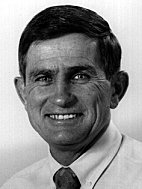 |
Steve Simpson
My support of Port Hacking has not changed but unless we look at all waterways of the Shire in a holistic way, we will fail all residents of the Shire. I am pleased with what the Hacking River Catchment Management Committee is doing, but my major concern is for my particular constituents of the George's River, where I am a member of the Catchment Management Committee. |
 |
Dawn Emerson
I have some concerns about the lack of focus on the possible environmental impacts of dredging and related works, in particular the lack of concern for the seagrass beds and turbidity or sediment going into areas of high biological importance. The implementation focus seems to be on boating without an equal concern for sustainability issues. |
|
Paul Smith |
 |
I enthusiastically believe that Council should encourage any measure that promotes the sustainable recreational use and environmental health of Port Hacking.
In my first term on Council I worked with community representatives in developing the Memorandum of Understanding. I still support it as the best framework for meeting the interests of recreational boating while maintaining the environmental integrity of the Port.
Unfortunately, little progress has been made in implementing all aspects of the Memorandum or the Council's own Plan of Management for Port Hacking. This is because Council's Port Hacking Planning & Advisory Committee is becoming the hobby horse of narrow vested interests. Only by maintaining an advisory committee that is representative of community opinion can the best interests of the Port be served.
Council is no longer driving Port Hacking planning. Initiatives have fallen to other groups such as the Hacking River Catchment Management Committee, whose leadership in the recent community contract process I applaud. Council needs to show similar leadership to bring people together rather than divide them.
Urban run off into Port Hacking is a major issue. Positively, the current Council has restored funding for run off programs after initially making these programs a low priority.
The key to the problem of run off is Council's open slather approach to development. Last year Council approved more units than any other Council in Sydney, and most of these did not comply with Council's own rules. An environmentally sustainable approach to development is the key to protecting Port Hacking from urban run off.
That is why I oppose weakening Council's controls on development as proposed in LEP amendment 57. Decreasing landscaping requirements while increasing allowable development in environmentally sensitive areas is a step in the wrong direction.
Recent road works in Bundeena showed that Council did not consider sediment disposal issues in road work design. The lack of action in prosecuting run off from a large Miranda unit site in Ewey Creek is an example of where Council's rhetoric is not matched with action.
Council needs to work with the community and to have a holistic approach in order to achieve the best environmental management of the Port and the Shire as a whole.
I believe that we can do better than we have done. Phil Blight |
 |
1. I support the Memorandum of Understanding (MOU) particularly because I was the Chair of the Port Hacking Planning and Advisory Committee (PHPAC) when it was drawn up. The MOU has largely been ignored since the new Council came into being in 1995.
2. As Chair of PHPAC in 1994-5, the Plan of Management (POM) was the guideline being used by Council to improve Port Hacking from its neglect, whether through preventing further sediment, improving water quality or achieving dredging of the navigation channels. Since 1995, the POM has hardly even been mentioned on Council. I doubt that many new Councillors have even seen a copy. It needs to be reviewed and hopefully the next Council, following the election in September, 1999, will try to ensure that it is implemented.
3. Since 1995, the only improvement the Liberal dominated Council has even considered is encouraging pump-out facilities for the few large boats that have holding tanks, but little success has been achieved. However, the State EPA already bans sewerage discharge. Meetings of the PHPAC are irregular and infrequent and when they are held they become very tedious. Council needs to stop over development in the Shire, stop sediment entering the Port and return the small bays to a more natural state by removing the sediment which has filled the bays since development started. Work on this has halted since 1995.
4. Little will be achieved by September, 1999. The Port doesn't have a high profile with the current controlling group on Council. They even tend to reply to questions as a group as their knowledge of the Port and its problems is so limited. After the election the new Council will need to address these problems, which have just been building up. They include protecting the upper catchment, reducing pollution from its many sources, improving water quality and controlling irresponsible and dangerous power vessels.
Concern needs to be expressed over the attempted change to the composition of Council's PHPAC. The current chair is trying to reduce the number of residents on the committee, while increasing the business representatives on the committee, which would give them control. Even environmental groups may not have any representatives on the committee. Byron Hurst |
 |
1. My support for the Memorandum is as before. Currently I am supporting the latest plan to transport dredged sand to offshore Cronulla Beach.
2. My support for the Sutherland Shire Council's Plan of Management for Port Hacking is as before. I am continuing to work through the Integrated Environmental Management Committee and Bushcare Forum chairmanship to bring about, for example:
-
Listing of Port Hacking Rainforest remnants which has now been recommended for protection as Endangered Plant Community.
-
Investigation of sewerage contamination of Gunnamatta Baths.
-
Development of Water Quality, Air Quality policies.
-
New landscape DCP.
-
Bushcare volunteers for Rutherford Reserve, Burraneer from Padstow TAFE Bushcare students.
-
Ongoing education and enforcement on sediment control from building sites.
I also work with the Ron Tonkin Park Bushcare Group.
3. Important Environmental Issues addressed:
-
sewerage contamination
-
campaign to upgrade pipelines (this is a slow continuing grind).
-
Bundeena/Maianbar DCP
-
moved involvement of the Environmental Science Unit in preparing DCP to incorporate ecologically sustainable design.
-
Ongoing education and enforcement of Tree Protection.
-
Lobbied for increased money in the 97/98 budget for Gross Pollution Traps and Wetlands in the Catchment.
-
Prevented rezoning of Shell Road bushland for high density housing (Gunnamatta Bay).
-
Secured increased budget for street tree planting of indigenous species.
-
Also secured increased budget for Bushcare, for position of Weeds Officer, and supported creation of Riverkeeper position for Port Hacking.
4. Current Issues:
-
Bundeena DCP.
-
Improved conservation performance on Aboriginal sites within Port Hacking and promotion and public education thereof.
-
Control dual occupancies subdivision and medium density in foreshore areas (wish me luck!) LEP debate upcoming.
-
98/99 budget
-
hope to gain additional funding for Bushcare, weed control, water quality devices, street tree planting, construction on-site sediment control enforcement.
David Redmond
|
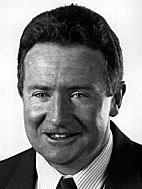 |
Sutherland Shire Council has in train a program to put in place three wetlands to improve water quality. The first is at Engadine, into Engadine Creek, which also includes a Gross Pollutant Trap (already in place). The second is due for commencement in February at Tudor Road, Jannali (which is part of the George's River catchment). This will bring the total of manmade wetlands to three (including the wetland already at Mianga Avenue, Engadine). All these areas have been the subject of Sutherland Shire Council environmental audits and were classified as badly degraded. The Sutherland Shire Council has increased its budget on environmental projects by some 200% as a direct result of community surveys which show the high value placed on environmental issues by the community.
Jill Deering
No comment received
Brett Thomas
No comment received
Tom White
No comment received
Andrew Hodson
No comment received
What is HRCMC?
The HRCMC is the Hacking River Catchment Management Committee. This committee has the responsibility to promote the coordinated and sustainable use of resources in the Hacking River catchment. It is one of forty CMCs (Catchment Management Committees) established in the early 1990s to promote management of the environment on a catchment basis. CMCs are set up under the Catchment Management Act (1989).
The NSW Minister of Land and Water Conservation appoints members to the Catchment Management Committee. Committee members are a mix of local community (land holders and users), people with an environmental interest in the catchment, representatives of both local Councils (Sutherland and Wollongong) and NSW State government agencies who have a management role in the catchment. The Department of Land and Water Conservation (DLWC) provides financial and technical assistance to the committee, and each CMC has a paid coordinator. Committee members give their time voluntarily and must seek re-appointment (or retire) after a specified number of years.
Calls for Expression of Interest to apply for vacancies on the committee are currently being advertised (in the local media and other outlets). Committee appointments are usually for a three-year term.
Non committee members are welcome to attend committee meetings and all are welcome to participate. Meetings are held on the 4th Wednesday of each month on Level 2 at Sutherland Shire Council, Eton Street Sutherland.
The objectives of the Committee are to:
-
Coordinate policies, programs and activities as they relate to the total catchment;
-
Achieve community participation in natural resource management;
-
Identify and rectify natural resource degradation;
-
Promote the sustainable use of natural resources; and
-
Provide stable and productive soil, high quality water and protective and productive vegetative cover within each of the State's water catchments.
The HRCMC's activities and achievements are regularly reported in the Protectorate, including: Distribution of small grants (less than $5,000) to community groups for catchment based activities; coordination of water quality monitoring in the catchment and biodiversity surveys; production of the Pollution Source Inventory; organisation of Community Forums; expert input into a range of environment management issues in the catchment; and ongoing surveys of the community to gauge relevance of HRCMC activities.
A recent survey of committee members, local government, state government agencies, industry groups, community groups, and educational facilities regarding the activities of HRCMC delivered a number of clear messages:
-
The HRCMC is doing a good job
-
The HRCMC needs to communicate its activities to the wider public and provide a better educative role
-
In line with results from other surveys of the community, participants in this survey nominated water quality as a key concern that the HRCMC should be focused on. Other issues that were also given high priority (and are of course linked to water quality) were sediment and erosion control.
-
Survey participants also believed that the HRCMC should continue to lobby actively for integrated management of the waterway.
TCM Structure |
 |
Sutherland Shire Council Draft Landscape Development Control Plan
The DCP (see also Protectorate 17) is a welcome step in protecting the leafy, shady, native bushland character of much of the Sutherland Shire. It will become part of the Council's operating plans next year (modified to take account of submissions on the draft).
The DCP will require a landscaping plan for: multiple occupancy developments, industrial and commercial development, recreational and tourism facilities, swimming pools located within the Foreshore Building Line, and tennis courts. The landscaping plan must be submitted together with applications for development and will be assessed as an integral part of the application. It must be prepared by a suitably qualified Landscape Architect, Landscape Designer, or Horticulturist with relevant design experience.
Will the DCP be enough to protect the natural character of the Shire? Probably not, unless it is strengthened and extended to include other residential development, and unless we all do our bit.
Most surveys of community concerns show that natural bushland setting is an important part of the Shire experience. Longer-term residents, however, note the incremental loss of suburban bushland. Redevelopment is often done at the expense of trees and bush. Every old tree removed (sometimes for good reasons!) and not replaced, and displacement of native bush with exotic lawns and plants impacts the natural character of the area. Along the foreshores of the Hacking, we see natural vista being replaced by manmade constructions, some breathtaking in their imposition on the natural scene.
Protecting mature native trees is good. But trees do die, or develop rot, or become a hazard to residents, or become an impediment to permitted development. The replacement trees do not spring up fully formed as required - they come from the under-story. Preservation of natural trees, therefore, requires protection of at least some degree of under-story. The under-story, which also contains shrubs and bushes is also important if we want to do more than protect trees. A substantial part of the native fauna live in the understorey - at times even finding escape from the cats and dogs.
The need for protection of bushland on residential blocks is even more important when water quality is considered. Native bush acts as a filter and limits pollution into the water. |
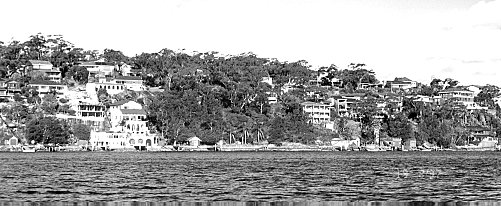
 |
A trip on the Port Hacking waterway illustrates both best and worst practice in the management of the landscape. Some natural vista has been replaced by concrete pylons supporting swimming pools or cabanas (which must look nice from the house but are an abuse of the aesthetics of the Port), or whole gardens has been turned over to hard paving and lawn, exacerbating unfiltered runoff into the Port. On other house blocks, where the owners have preserved the native vegetation, it is hard to even see a house. These owners have hidden their construction, and created a haven that is pleasant for them, and sensitive to their environment.
It is not by accident that the greatest gardens, overlooking the most magnificent vistas, are most often photographed through a frame or screen of trees. This is more interesting and beautiful than a blank panorama of distant scenes. Preserving the trees and screening or framing the view actually improves it and makes it more interesting. Removing trees to 'improve the view' is often the most effective way of removing interest, light, shade and depth. It frequently deteriorates the view and takes away some of the pleasure of the aspect.
Sutherland Shire Council has made a start with this DCP, and is to be congratulated for doing so. But there is a lot more that can be done by Council and by the community. |
What can you do to preserve the natural beauty of your part of the Shire?
-
Minimise hard surfacing - timber walkways and gardens with stepping stones are far more sensitive to the environment ( and often cheaper to install).
-
If in doubt, choose a native (and local) plant over an exotic. Let some of the self seeded natives grow to maturity - generally they will reward you with little effort on your part.
-
Don't keep one native tree specimen - create a small grove, so that they can replace themselves over time.
-
Don't use lawn, unless you really have no choice. There is a myriad of native plants that are just as attractive, require less maintenance, and help to preserve the biodiversity of nature.
-
Join a bushcare group and help to look after an area near you.
-
Look at your garden from the perspective of someone looking in (particularly if you live on the waterway) and consider how you can preserve some of the natural feel of the landscape we all value
|
General Objectives of the draft Landscape Development Plan:
-
Maintain and enhance the existing landscape character of the Sutherland Shire and ensure proposed developments do not threaten the viability of natural features and ecosystems.
-
Protect and improve wildlife corridors and vegetation links between bushland areas by retaining, regenerating and promoting the planting of indigenous trees, shrubs and ground covers.
-
Improve visual quality and integration of new developments to existing area and surrounding streetscape with high quality landscaping.
-
Ensure that proposed landscape works are designed, documented and constructed in a professional manner acceptable to Council and the community.
-
Ensure landscape works complement the design of the proposal so as to reduce the scale, mass and bulk of the built form and to satisfy functional requirements such as privacy, shade and wind buffers.
-
Ensure landscape works reflect the natural attributes of the location and surrounding landscape.
-
Improve habitat for aquatic fauna and flora by vegetative filtering of pollutants from urban run-off.
-
Encourage low maintenance, and low water usage by the use of native plants, and by directing stormwater to garden areas.
|
|
Dear Editor - By Phone
We have had several calls and approaches from members about the deteriorating state of huts at Bonnie Vale (see photo). One caller pointed out that with the summer coming and an increased usage rate at Bonny Vale, the likelihood of accidents and increased vandalism would rise. "If I had that sort of mess in my backyard I'd be told I'd have to clear it up or I'd get fined," one caller complained. |
 |
We contacted NPWS about the state of the cabins at Bonnie Vale. They stated that they are most concerned about the state of the cabins. They have carried out a survey of the area. Their next step is to involve stakeholders in precinct planning.
A concerned resident informed us that a significant amount of sediment had made its way into Yowie Bay in August. The sediment settled next to the Wonga Road wharf.
Investigations showed that the sediment came from Sutherland Shire Council roadworks in Wonga Road, washed down by the heavy rains. Sutherland Shire Council have carried out an initial clean up. They have been requested by NSW Fisheries to remove more of the material as it is impacting adversly on the natural habitat. Dear Editor - By Letter
Pristine Waters - reclassification threat
A letter was sent by the Sutherland Shire Environment Centre objecting to the EPA Proposal for Interim Water Quality classification of the Hacking River to all Ministers of the State cabinet who will decide on the classification of the Hacking. Most have replied stating that the new water classifications are a matter for the Environment Minister, Pam Allen.
Pam Allen has not responded.
Since this letter was written we have had a major sewerage spill at Helensburgh, and Cronulla Beach is again a health hazard.
We have had an election where a candidate was handicapped by the contamination of Sydney's drinking water.
The State Government would do well to reflect upon the 1988 State Election when Barry Unsworth ignored the save the Hacking issues and lost the seat of Heathcote for the first time in the history of the Labour Party. Tim Tapsell
Stuffing up letter boxes - and waterways
Dear Editor,
At this time of year our letter boxes become fair game for the glossy advertisements pushing all kinds of wasteful material 'gifts'. Much of this paper gets blown or thrown on the streets by frustrated residents disgusted at the continual barrage by the greedy exploiters stuffing up their 'letter' boxes. The hardpressed official mail person delivering the real mail continually needs to wrench the junk mail out to get the letters in.
So there is a dilemma - in many more ways than one.
Being a deliverer of the PHPS newsletter over the past years, three or four times a year to many thousands of Port Hacking waterfront and near-water front houses, one gets to observe heaps of windblown, waterlogged junk mail mingling with the cigarette butts (toxic pellets) etc. wending their wasting, wasteful way - waterways.
When the opportunity arises I ask people if they consider The Protectorate as junk mail; "never! we really appreciate it" is invariably the reply.
Heartening it is seeing the increase of NO JUNK MAIL etc. appearing on concerned residents' letterboxes, some are simply felt-penned on. Letting them know how appreciated is the NO JUNK MAIL (or equivalent) by mail persons reaffirms our mutual concern for our planet's future.
NO JUNK MAIL in our waterways - NO BUTTS!
An ancient mariner's voice for an ancient marine life. Billy Snow Applications for Funding
Funding is available from various government authorities for community projects. Application forms are currently available for the following two sources:
Natural Heritage Trust (NHT)
The NHT was created by the Commonwealth Government in 1996 and will invest $1.25 billion in Australia's natural heritage over its first five years. The Trust is a partnership between the Commonwealth, State and Territory governments. There are 18 programs under the overarching banner of NHT. Some of these programs include: Clean Seas and Oceans, Landcare, and Bushcare.
Rivercare
Rivercare projects are funded on a joint venture basis between DLWC and community groups/organisations only. Funds can be used for capital costs (materials), operating costs (equipment hire) and employment costs (for specialist skills). Eligible projects include: river management plans, revegetation, fencing and stock watering points, stream clearance, erosion control works, nutrient control plans, and nutrient control works.
The closing date for applications for both of these funding sources is 26th February 1999. Obtain applications for both of these funding sources from the HRCMC Coordinator, Libby Rawlingson, (02) 9895 7769. Putt Putt Regatta
The Annual Putt Putt Regatta is a charming use of the Port Hacking waterway. It is held annually each October. Proceeds go to charity. The following is a painting by Jenni Jervis of the Regatta. |
 |
| top of page |
|



